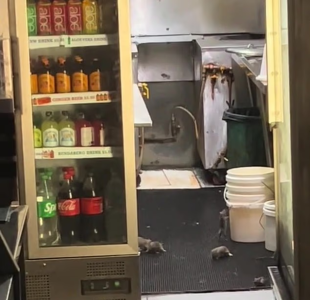Rats immune to poison, spreading disease—is this the next public health disaster?
By
Maan
- Replies 0
Rats immune to poison, taking over food courts, and spreading deadly disease—is Sydney on the brink of a rodent-fuelled health crisis?
Residents have watched, horrified, as rats scurried across shopping centres and eateries in broad daylight.
And as scientists warn of a genetic mutation turning these vermin into poison-resistant super-spreaders, the problem is escalating.
Rats had always been a part of city life, but since the Covid pandemic, Sydney’s rodent population had surged to disturbing levels.
Experts said construction across the city was pushing rats above ground, while irregular waste pick-up cycles left rubbish out longer, creating an open buffet for rodents.
Footage of rats infesting public spaces went viral on social media, including videos of giant rats running through the Westfield Parramatta food court and a swarm in the kitchen of a late-night Oxford Street kebab shop.
Nathaly Haeren, who owned pest control company Pesty Girls, said the vermin had become a problem ‘all across Sydney’.
She revealed requests for pest control services had skyrocketed since the pandemic, driven by a combination of construction disruption and increased food availability on the streets.
‘It’s the destruction they cause that blows my mind, that scares me, because I’m competing against them,’ Ms Haeren shared.
‘Rats need to keep gnawing to keep their teeth down. Their strength is like iron. And they can flatten to the size of your thumb—they’ve got hinged ribs … I need to be 10 steps ahead.’
Shaun Bankowski, owner of MOA Contract Shooting, said his team had tackled rodent outbreaks in everything from chicken farms to food manufacturing sites and shopping centres.
‘We’ve had sites where we’ve shot over 650 rats in four hours. The whole back of my HiLux was covered in rats—15 cm deep,’ he said.
He explained traditional pest control methods were no longer enough, as around 20 per cent of rat populations now survived poisoning and bred resistant colonies.
That claim was backed by recent research from Edith Cowan University, where environmental toxicologist and PhD student Alicia Gorbould discovered a mutation in more than half of the black rats tested across Sydney, Brisbane, Perth, and Melbourne between 2021 and 2024.
The mutation showed resistance to second-generation anticoagulant rodenticides (SGARs)—one of the most widely used poisons in Australia.
Ms Gorbould warned that public panic could lead to people using increasing quantities of poison in their homes, further fuelling the crisis.
‘If you’re using one of the baits that don’t work … people will probably try to use more, and more, and more,’ she said.
‘And so it’s feeding back into that cycle of increasing the rates of resistance in the population, increasing those non-targeted poisonings, and then we’re ending up essentially with a public health issue because we’ve got these rats that can’t be controlled.’
In 2019, Sydney recorded its first outbreak of leptospirosis—a bacterial infection spread via rodent urine that killed seven dogs and posed a deadly risk to humans.
Rats had long been associated with the transmission of severe diseases including plague, typhus, and Lyme disease—often via the fleas they carried.
Some historians believed rat-borne diseases had killed more people over the last 1,000 years than all global wars combined.
A City of Sydney spokesperson said rats posed serious health and safety risks through the spread of disease, food contamination, and structural damage caused by chewing and nesting.
Reports of infestations were common in public housing areas where communal bins offered easy access to food waste.
The city spent an estimated $240,000 annually on pest control, using a mix of baits, electronic traps, and a ‘risk-based rodent control program’ deployed in parks and high-activity zones.
More than 100 contractors worked across the program, with rat bait laid quarterly to prevent immunity from developing.
Ms Gorbould called for a more coordinated national approach, warning that relying on the same poison for over 50 years was no longer effective.
One alternative gaining attention involved reintroducing Australia’s native bush rat—an animal that lived away from humans, fed on seeds and nectar, and did not carry human diseases.
University of Sydney Professor of Conservation Biology, Peter Banks, said the goal was to block invasive black and Norway rats by replacing them with the bush rat population.
He and fellow researchers were already running reintroduction programs in areas around Sydney Harbour.
Mr Banks noted bush rats did not rely on human waste, lived in discreet burrows, and crucially—did not stink.
If you thought the Sydney rat crisis was bad, wait until you hear what turned up in someone’s salad.
It’s one thing to spot rodents on the streets—but quite another to find one on your plate at a restaurant.
In a separate but equally disturbing incident, a diner had an encounter that sparked outrage and a swift health investigation.
Read more: 'Unacceptable and disgusting': Customer finds rat in salad at popular restaurant

If super-rats can't be stopped with poison, what will it take to reclaim Australia's biggest city?
Residents have watched, horrified, as rats scurried across shopping centres and eateries in broad daylight.
And as scientists warn of a genetic mutation turning these vermin into poison-resistant super-spreaders, the problem is escalating.
Rats had always been a part of city life, but since the Covid pandemic, Sydney’s rodent population had surged to disturbing levels.
Experts said construction across the city was pushing rats above ground, while irregular waste pick-up cycles left rubbish out longer, creating an open buffet for rodents.
Footage of rats infesting public spaces went viral on social media, including videos of giant rats running through the Westfield Parramatta food court and a swarm in the kitchen of a late-night Oxford Street kebab shop.
Nathaly Haeren, who owned pest control company Pesty Girls, said the vermin had become a problem ‘all across Sydney’.
She revealed requests for pest control services had skyrocketed since the pandemic, driven by a combination of construction disruption and increased food availability on the streets.
‘It’s the destruction they cause that blows my mind, that scares me, because I’m competing against them,’ Ms Haeren shared.
‘Rats need to keep gnawing to keep their teeth down. Their strength is like iron. And they can flatten to the size of your thumb—they’ve got hinged ribs … I need to be 10 steps ahead.’
Shaun Bankowski, owner of MOA Contract Shooting, said his team had tackled rodent outbreaks in everything from chicken farms to food manufacturing sites and shopping centres.
‘We’ve had sites where we’ve shot over 650 rats in four hours. The whole back of my HiLux was covered in rats—15 cm deep,’ he said.
He explained traditional pest control methods were no longer enough, as around 20 per cent of rat populations now survived poisoning and bred resistant colonies.
That claim was backed by recent research from Edith Cowan University, where environmental toxicologist and PhD student Alicia Gorbould discovered a mutation in more than half of the black rats tested across Sydney, Brisbane, Perth, and Melbourne between 2021 and 2024.
The mutation showed resistance to second-generation anticoagulant rodenticides (SGARs)—one of the most widely used poisons in Australia.
Ms Gorbould warned that public panic could lead to people using increasing quantities of poison in their homes, further fuelling the crisis.
‘If you’re using one of the baits that don’t work … people will probably try to use more, and more, and more,’ she said.
‘And so it’s feeding back into that cycle of increasing the rates of resistance in the population, increasing those non-targeted poisonings, and then we’re ending up essentially with a public health issue because we’ve got these rats that can’t be controlled.’
In 2019, Sydney recorded its first outbreak of leptospirosis—a bacterial infection spread via rodent urine that killed seven dogs and posed a deadly risk to humans.
Rats had long been associated with the transmission of severe diseases including plague, typhus, and Lyme disease—often via the fleas they carried.
Some historians believed rat-borne diseases had killed more people over the last 1,000 years than all global wars combined.
A City of Sydney spokesperson said rats posed serious health and safety risks through the spread of disease, food contamination, and structural damage caused by chewing and nesting.
Reports of infestations were common in public housing areas where communal bins offered easy access to food waste.
The city spent an estimated $240,000 annually on pest control, using a mix of baits, electronic traps, and a ‘risk-based rodent control program’ deployed in parks and high-activity zones.
More than 100 contractors worked across the program, with rat bait laid quarterly to prevent immunity from developing.
Ms Gorbould called for a more coordinated national approach, warning that relying on the same poison for over 50 years was no longer effective.
One alternative gaining attention involved reintroducing Australia’s native bush rat—an animal that lived away from humans, fed on seeds and nectar, and did not carry human diseases.
University of Sydney Professor of Conservation Biology, Peter Banks, said the goal was to block invasive black and Norway rats by replacing them with the bush rat population.
He and fellow researchers were already running reintroduction programs in areas around Sydney Harbour.
Mr Banks noted bush rats did not rely on human waste, lived in discreet burrows, and crucially—did not stink.
If you thought the Sydney rat crisis was bad, wait until you hear what turned up in someone’s salad.
It’s one thing to spot rodents on the streets—but quite another to find one on your plate at a restaurant.
In a separate but equally disturbing incident, a diner had an encounter that sparked outrage and a swift health investigation.
Read more: 'Unacceptable and disgusting': Customer finds rat in salad at popular restaurant
Key Takeaways
- Sydney's rat population surged after the pandemic, fuelled by construction and waste collection delays.
- New research revealed rats had developed a genetic resistance to common poisons used in pest control.
- Experts warned of a looming public health crisis, with rodents spreading potentially fatal diseases.
- Authorities explored reintroducing native bush rats as a way to outcompete harmful invasive species.
If super-rats can't be stopped with poison, what will it take to reclaim Australia's biggest city?








